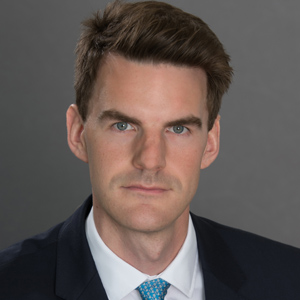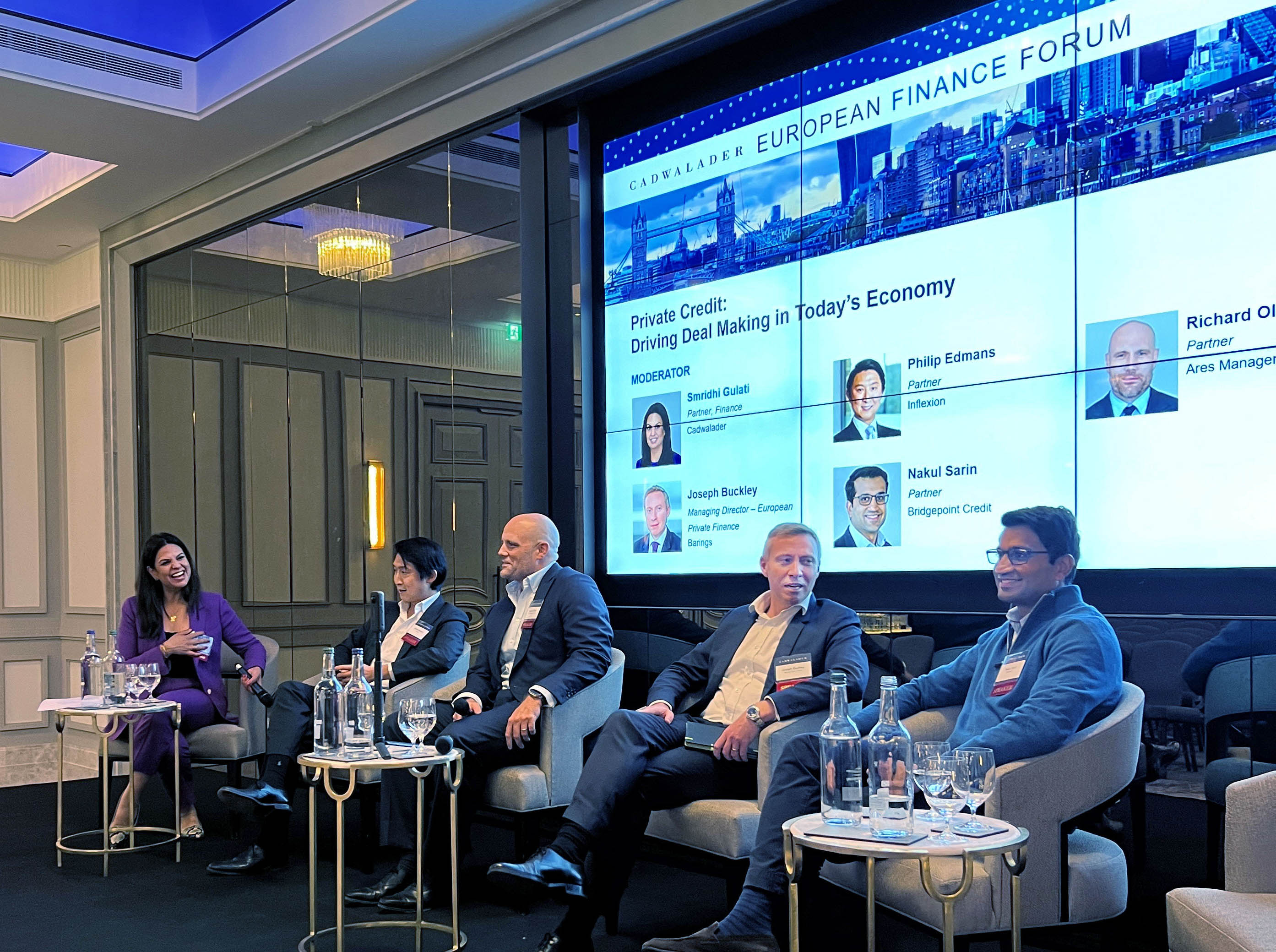
Special Counsel | Fund Finance

Thank you to all those who joined Cadwalader’s inaugural European Finance Forum last week. It was a fantastic program, with over 300 in attendance to learn from leading professionals in private capital, debt finance and more. We are grateful to our industry expert speakers, clients and all attendees who took the time to participate in the event's dynamic discussions and networking opportunities.
Our panels focused on four key areas: current developments in ESG, liquidity challenges for private markets managers, driving private credit deal-making and trends and opportunities in the broadly syndicated and middle markets. Our panels were followed by a fireside chat with Danny Mays, BAFTA nominated actor, who gave insights into his successful career and the charities that inspire his work.
A brief recap of each of the panels:
Panel 1: ESG Outlook: What’s Next for ESG Investment and Finance?

In our first panel of the day, Jack David (Head of ESG at 9fin), Sabrina Fox (CEO at the European Leveraged Finance Association) and Ryan Kisiel (Partner and Head of Sustainability at H/Advisors Maitland) discussed the latest developments in ESG and sustainability. Cadwalader Partner and Co-chair of ESG Sukhvir Basran started by looking back on what has been a choppy year for ESG and sustainability. The increase in ESG disclosure and reporting continues with the Corporate Sustainability Reporting Directive (CSRD) taking effect, the ISSB Standards being launched and, more recently, the Taskforce for Nature-related Financial Disclosures (TNFD) releasing its final recommendations. The interrelated nature of sustainability-related reporting and disclosure requirements and the extra-territorial impact of the CSRD continues to present challenges across the market, with some market participants emphasising the misalignment between reporting obligations (including for example the obligations on companies under the CSRD and those on market participants under the SFDR).
Panellists exchanged their views on how the market is responding to regulation and the demand for ESG integration with Sabrina Fox highlighting the increased organisational shift within the finance sector generally, with many firms now employing specialist ESG teams to help navigate an evolving regulatory landscape. She noted that trade associations reporting frameworks and peer-peer learning opportunities are also supporting these efforts. Together, these assist in forming a coherent market response to regulatory consultations, which are ongoing. Whilst panellists agreed that data remains a challenge, Jack David emphasised the important balancing act required between the collection of granular data for investors and stakeholders to conduct meaningful, forward-looking analysis, and overloading companies and investors with arduous reporting on factors that may not be material.
Overall however, the panellists agreed that increased transparency and standardisation has significantly improved data flow and focused attention on reducing emissions and improving the design and implementation of relevant systems and processes.
The panellists examined the anti-ESG sentiment which now seems to be a widespread feature of political debate in the UK, Europe and the US and the impact that is expected to have on sustainable finance and investment. This has left some asset managers balancing the divergent views whilst also responding to increased demands for better ESG integration and credible sustainable finance structures. Ryan Kisiel emphasised that there is heightened scrutiny of the term “ESG” , with allegations of greenwashing partly fuelling this scrutiny. The panellists agreed that this heightened scrutiny has increased the need for careful communication, a deeper understanding of relevant terms, robust and credible sustainable finance products and structures and the need for net-positive impact to form part of credit analysis.
Panellists generally agreed sustainable finance and investment, alongside ESG integration, will continue to face increased scrutiny in 2024 but suggested that, ultimately, this can be a positive thing, leading to more collaboration, industry frameworks and toolkits and better designed processes, systems and finance structures. The industry will need to provide concrete solutions to the various obstacles it faces in order to implement a “just and fair transition for everyone”. The consensus among the panel was clear: despite its many challenges, sustainable finance and investment is here to stay.
Panel 2: Liquidity Challenges for Private Markets Funds

In challenging markets, looking for ways to meet the liquidity needs of private markets funds has been a key focus for many. Our second panel of the day brought together various industry experts to discuss these challenges and potential solutions. Panellists included Steve Burton (Head of Fund Finance at ICG plc), Stephen Thomas (Head of Finance at Coller Capital), David Wilson (Co-Head of Credit at 17Capital) and Michael Hubbard (Head of European GP Solutions at Cadwalader).
The panel was moderated by Cadwalader Partner, Samantha Hutchinson, who began discussions by reflecting on the monumental growth witnessed in the fund finance market over the last 20 years: what once was regarded as relatively niche, primarily relationship-driven product, now encapsulates an industry estimated to be valued at over one trillion USD. So, has the fund finance market grown “too quickly, too soon”? And how can private markets managers ensure they have the liquidity they need?
Clearly, we are no longer living in a time of “easy money”. David Wilson explained that this means firms need to “try harder” in order to source the right type of liquidity for funds’ specific financing needs. ICG’s Steve Burton agreed and commented that where previously firms were focused on working with one or two key lenders, they are now faced with the challenge of developing and maintaining relationships with a much larger syndicate. This, the panel agreed, was reflective of a maturing market; with Stephen Thomas pointing out that a mismatch in supply and demand has forced borrowers to build long-term relationships with a range of credit providers rather than focussing solely on resolving immediate liquidity issues. The panel reflected that the shift in market dynamics has made it increasingly difficult for many sponsors to finance their ongoing operations and investment needs. Michael Hubbard explained that this could be particularly challenging for small and mid-market players that have concentrated investor bases and/or a less established manager than other firms competing for credit.
The panel considered the impact that this increased time and resource required to manage the products and relationships was having on managers and panellists agreed that it was giving rise to more expertise being brought in-house and more advisors being used on transactions.
Panellists exchanged their thoughts on the implications of current pricing levels and implications for fund finance products. It was agreed that new structures and solutions are needed to unlock existing pockets of liquidity and create valid alternatives for both GPs and lenders. There is a clear liquidity shortage – currently masked by tempered fund-raising levels – and this represents a huge opportunity for institutional solutions. Whether this can be achieved at scale remains to be seen but the panel were unanimous: whatever happens next, the world of fund finance is going to continue to evolve rapidly.
Panel 3: Private Credit: Driving Deal Making in Today’s Economy

This panel featured Joseph Buckley (Managing Director –in Barings’ Global Private Finance Group), Philip Edmans (Partner at Inflexion Private Equity), Richard Oliver (Partner at Ares Management) and Nakul Sarin (Partner at Bridgepoint Credit) and was moderated by Cadwalader Partner, Smridhi Gulati.
The panel began by discussing whether the current economic climate, and in particular the reduction in levels of deal activity since 2021, had brought about a change in approach to their origination strategies. The general consensus of the panel being “yes and no” and that a “consistent strategy with different tactics” was key. In a high rate environment, institutions will likely look more closely at who they do business with, rather than the business strategy itself. A key takeaway was that maintaining core relationships and not losing a focus on terms remained integral to these institutions (both from a lender and a sponsor perspective). The panellists also discussed whether sponsors/borrowers have recently developed a “club mentality” when it comes to structuring the debt-financing component of their investments and, in particular, whether we are seeing the resurgence of bank club deals. Comment was made that sponsors in the mid-market certainly see the rationale in building capacity and relationships among a diverse group of lenders, as opposed to looking to bring multiple lenders into a process in order to play them off against one another. Lenders are generally viewed as rational, well-organised institutions and it is often the case that dealing with a one lender on a bilateral basis can be more efficient and result in better commercial terms.
Panellists also noted that, whilst rising interest rates meant banks were becoming more competitive on certain deals (particularly those structured using less leverage), capacity restraints would continue to make it difficult for them to compete on more highly-levered transactions or those requiring more material facilities. That said, increased competition from banks is “no bad thing” according to one panellist, who viewed it as a clear indication that Private Credit is growing up as an asset class. Given the vast amounts of dry powder in the PE industry, there are huge opportunities within the market for a wide range of participants. Touching on whether funds were subject to increased investor oversight, panellists confirmed they were seeing increased scrutiny on terms, and questions had also started arising on how lawyers were being appointed for the lenders – sponsor designation being questioned for the credit funds. Increased scrutiny looked to be welcomed by the panellists in a more competitive lending market, with panellist agreeing that their investors were sophisticated institutions. For those of the panel representing credit funds, there was a consensus that now is the time to prove yourself as a manager.
Panellists were then asked if their approach to structuring had also changed in the current environment in order to enhance value creation. The panel noted that they were actually seeing less issuances of holdco PIK and other junior debt instruments as risk appetite had tightened – on both sides of the table. The focus looked to be more of a senior debt strategy for most, with a shift in giving more flexibility around cash preservation for borrowers and keeping ahead of liquidity issues. In this respect, the ‘PIK toggle’ feature was becoming increasingly commonplace and important tool for borrowers.
The session ended with some crystal ball gazing into 2024. Generally, the mood amongst panellists was one of great optimism, with all speakers expecting a very busy credit market in the new year. Final thoughts were that “deals get deferred, they don’t go away” with the conclusion that “Q1 is the new Q4”.
Panel 4: Leveraging Loan Portfolios: Trends and Opportunities in the Broadly Syndicated and Middle Markets

The final panel of the day featured Sandeep Chana (Director, Structured Credit / CLOs at S&P Global Ratings), Marc Goldberg (Managing Director; Head of EMEA FICC Financing at Bank of America), Gavin Lau (Finance Director & Head of Operations at LGT Private Debt), Vincent Lepoutre (Managing Director, Securitised Products Group at BNP Paribas) and Rhita Sami (Head of Asset Financing at Hayfin).
Cadwalader Partner Nick Shiren set the scene as moderator, explaining that the session would focus on NAV facilities backed by an underlying pool of debt (in the form of loans, notes or bonds etc. made available in the middle market). These products can often take on hybrid characteristics, sometimes being secured against not only the underlying loans held by a borrower (typically a debt fund) but also the uncalled investor commitments in that borrower.
Panellists discussed the importance of these products and how they represent a vital part of a fund’s financial toolkit. It was noted that such financings allow GPs to employ leverage throughout the lifecycle of the fund but stressed that those looking to take advantage of these facilities need to consider a range of factors, even before launching the fund. This is particularly the case where they are looking for strong commercial terms as part of a competitive lender process. The panel discussed that funds should ensure that they have a well defined leverage strategy that allows them to put such financings in place without the need for additional investor consents. Borrowers should also be mindful of the kind of “eligibility criteria” to which the underlying loans will be subject under these facilities. A focus on diversity of underlying obligors in terms of sector and geography will assist all borrowers in obtaining credit against their loan portfolios. Moreover, minimum EBIDTA and concentration limits are also key factors in determining whether the underlying loans can be counted for borrowing base purposes.
Vincent Lepoutre and Marc Goldberg provided insight from the perspective of a lender in these kinds of transactions. Echoing the sentiments of the rest of the panel, they commented that it is not the role of the lender to influence or dictate the investment strategy or leverage policy of the fund but rather to play a constructive role in assisting funds with their liquidity needs. In order to do this, lenders need experience in this asset class and a deep understanding of the market. One issue that is typically debated in these types of facilities is the way in which the underlying assets are valued. As one panellist pointed out, lenders generally need to be able to get comfortable with a sponsor’s valuation methodology so that they are aligned with investors in the fund. That notwithstanding, lenders will often want the right to appoint a third party valuer following certain “credit trigger events”.
Panellists then turned their attention to the size of the market. They discussed that the proliferation of these products has been accelerated in recent years, most notably as a result of the inability of companies to refinance using the public markets, which has led many sponsors to seek alternative forms of finance in the private markets. We are also seeing increased demand within the European funds market as managers continue to attract investors more accustomed to a leveraged strategy. Moreover, notwithstanding the current inflationary environment, there has not been a dramatic increase in the relative cost of these products. Panellists varied in their views but estimated the total market size of these facilities as being in the region 10-20 billion euros.
Nick closed discussions by asking panellists if they expect to see a mid-market CLO issued in the next year. Sandeep outlined the various challenges in launching these kinds of products, most notably as a result of a lack of diversity, FX risk and increased concentration risk within the mid-market. However, despite these challenges, he anticipates that at least one European CLO will be issued in the next 12-18 months. Watch this space.
Final Thoughts
We were delighted to be able to host such a topical, insightful event covering some of the most important issues and opportunities facing the clients of our European Finance and we’re already looking forward to next year!











